Suppose that I have data on gender distribution (female, male, divers) in three different countries (USA, Nepal, Japan) with three different locations each (province, small town, city) for two years (2019, 2022).
I want to display all of these data in a facet grid of bar plots, dividing columns by gender type. Specifically, I want the gender types to be displayed as stacked, patterned (not coloured!) subcolumns. Is that possible?
My code and the "dream illustriation" are provided below:
data <- structure(list(year = c(2019, 2019, 2019, 2019, 2019, 2019, 2019,
2019, 2019, 2019, 2019, 2019, 2019, 2019, 2019, 2019, 2019, 2019,
2019, 2019, 2019, 2019, 2019, 2019, 2019, 2019, 2019, 2022, 2022,
2022, 2022, 2022, 2022, 2022, 2022, 2022, 2022, 2022, 2022, 2022,
2022, 2022, 2022, 2022, 2022, 2022, 2022, 2022, 2022, 2022, 2022,
2022, 2022, 2022), country = c("USA", "USA", "USA", "USA", "USA",
"USA", "USA", "USA", "USA", "Nepal", "Nepal", "Nepal", "Nepal",
"Nepal", "Nepal", "Nepal", "Nepal", "Nepal", "Japan", "Japan",
"Japan", "Japan", "Japan", "Japan", "Japan", "Japan", "Japan",
"USA", "USA", "USA", "USA", "USA", "USA", "USA", "USA", "USA",
"Nepal", "Nepal", "Nepal", "Nepal", "Nepal", "Nepal", "Nepal",
"Nepal", "Nepal", "Japan", "Japan", "Japan", "Japan", "Japan",
"Japan", "Japan", "Japan", "Japan"), location = c("province",
"province", "province", "small town", "small town", "small town",
"city", "city", "city", "province", "province", "province", "small town",
"small town", "small town", "city", "city", "city", "province",
"province", "province", "small town", "small town", "small town",
"city", "city", "city", "province", "province", "province", "small town",
"small town", "small town", "city", "city", "city", "province",
"province", "province", "small town", "small town", "small town",
"city", "city", "city", "province", "province", "province", "small town",
"small town", "small town", "city", "city", "city"), gender = c("male",
"female", "divers", "male", "female", "divers", "male", "female",
"divers", "male", "female", "divers", "male", "female", "divers",
"male", "female", "divers", "male", "female", "divers", "male",
"female", "divers", "male", "female", "divers", "male", "female",
"divers", "male", "female", "divers", "male", "female", "divers",
"male", "female", "divers", "male", "female", "divers", "male",
"female", "divers", "male", "female", "divers", "male", "female",
"divers", "male", "female", "divers"), quantity = c(6, 5, 1,
7, 7, 2, 15, 18, 4, 4, 8, 0, 5, 6, 1, 11, 12, 4, 9, 4, 3, 8,
8, 1, 16, 13, 0, 7, 5, 0, 6, 4, 2, 18, 17, 2, 5, 7, 0, 6, 6,
2, 14, 10, 1, 5, 6, 1, 6, 4, 2, 14, 10, 5), total = c(12, NA,
NA, 16, NA, NA, 37, NA, NA, 12, NA, NA, 12, NA, NA, 27, NA, NA,
16, NA, NA, 17, NA, NA, 29, NA, NA, 12, NA, NA, 12, NA, NA, 37,
NA, NA, 12, NA, NA, 14, NA, NA, 25, NA, NA, 12, NA, NA, 12, NA,
NA, 29, NA, NA)), class = c("tbl_df", "tbl", "data.frame"), row.names = c(NA,
-54L))
data <- data %>%
mutate(across(year, factor, levels = c("2019","2022"))) %>%
mutate(across(country, factor, levels = c("USA", "Nepal", "Japan"))) %>%
mutate(across(location, factor, levels = c("province", "small town", "city"))) %>%
mutate(across(gender, factor, levels = c("male", "female", "divers")))
ggplot(data, aes(y = total, x = location, fill = country)) +
geom_col(position = position_dodge(width = 0.5), size = .5, width = .5) +
labs(x = "Year", y = "Count") +
scale_y_continuous(expand = c(0, 0), limits = c(0, 40), breaks = seq(0, 40, by = 10)) +
scale_fill_manual(values = c("blue", "green", "red"), name = "Country") +
scale_color_manual(values = c("black", "black", "black")) +
facet_grid(rows = vars(country), cols = vars(year)) +
theme(panel.background = element_rect(fill = "white"),
panel.spacing = unit(.7, "cm"),
strip.background = element_blank(),
panel.border = element_rect(fill = "transparent", colour = "black"),
strip.text = element_text(size = 14),
axis.text = element_text(size = 12, colour="black"),
axis.title = element_text(size = 14, colour = "black"),
legend.position = "bottom",
legend.background = element_rect(fill = "white"),
legend.text = element_text(size = 12),
legend.title = element_text(size = 14))

